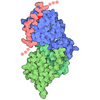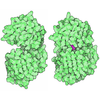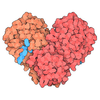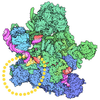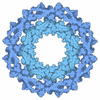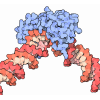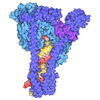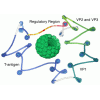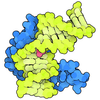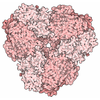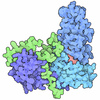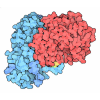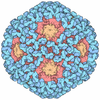[English] 日本語
 Yorodumi
Yorodumi- PDB-6r6h: Structural basis of Cullin-2 RING E3 ligase regulation by the COP... -
+ Open data
Open data
- Basic information
Basic information
| Entry | Database: PDB / ID: 6r6h | ||||||
|---|---|---|---|---|---|---|---|
| Title | Structural basis of Cullin-2 RING E3 ligase regulation by the COP9 signalosome | ||||||
 Components Components |
| ||||||
 Keywords Keywords | LIGASE / Cullin-Ring E3 Ligase COP9 Signalosome Neddylation | ||||||
| Function / homology |  Function and homology information Function and homology informationnucleotide-excision repair factor 4 complex / COP9 signalosome assembly / trophectodermal cell proliferation / macrophage migration inhibitory factor binding / regulation of IRE1-mediated unfolded protein response / global genome nucleotide-excision repair / exosomal secretion / GTPase inhibitor activity / deNEDDylase activity / protein deneddylation ...nucleotide-excision repair factor 4 complex / COP9 signalosome assembly / trophectodermal cell proliferation / macrophage migration inhibitory factor binding / regulation of IRE1-mediated unfolded protein response / global genome nucleotide-excision repair / exosomal secretion / GTPase inhibitor activity / deNEDDylase activity / protein deneddylation / eukaryotic translation initiation factor 3 complex / regulation of protein neddylation / activation of NF-kappaB-inducing kinase activity / regulation of cellular response to hypoxia / cullin-RING-type E3 NEDD8 transferase / NEDD8 transferase activity / COP9 signalosome / cullin-RING ubiquitin ligase complex / RHOBTB3 ATPase cycle / negative regulation of receptor signaling pathway via JAK-STAT / cellular response to chemical stress / Cul7-RING ubiquitin ligase complex / ubiquitin-dependent protein catabolic process via the C-end degron rule pathway / Loss of Function of FBXW7 in Cancer and NOTCH1 Signaling / transcription elongation factor activity / target-directed miRNA degradation / elongin complex / positive regulation of protein autoubiquitination / RNA polymerase II transcription initiation surveillance / protein neddylation / Replication of the SARS-CoV-1 genome / metal-dependent deubiquitinase activity / Hydrolases; Acting on peptide bonds (peptidases) / regulation of JNK cascade / NEDD8 ligase activity / VCB complex / RHOBTB1 GTPase cycle / negative regulation of response to oxidative stress / Cul5-RING ubiquitin ligase complex / regulation of DNA damage response, signal transduction by p53 class mediator / inner cell mass cell proliferation / SCF ubiquitin ligase complex / Cul2-RING ubiquitin ligase complex / negative regulation of type I interferon production / ubiquitin-ubiquitin ligase activity / intracellular membraneless organelle / SCF-dependent proteasomal ubiquitin-dependent protein catabolic process / TP53 Regulates Transcription of DNA Repair Genes / Cul4A-RING E3 ubiquitin ligase complex / Cul4-RING E3 ubiquitin ligase complex / Cul3-RING ubiquitin ligase complex / Cul4B-RING E3 ubiquitin ligase complex / ubiquitin ligase complex scaffold activity / SUMOylation of ubiquitinylation proteins / negative regulation of mitophagy / Prolactin receptor signaling / response to light stimulus / cullin family protein binding / Antigen processing: Ubiquitination & Proteasome degradation / skeletal muscle cell differentiation / Pausing and recovery of Tat-mediated HIV elongation / Tat-mediated HIV elongation arrest and recovery / negative regulation of transcription elongation by RNA polymerase II / HIV elongation arrest and recovery / Pausing and recovery of HIV elongation / protein monoubiquitination / negative regulation of signal transduction / Tat-mediated elongation of the HIV-1 transcript / Formation of HIV-1 elongation complex containing HIV-1 Tat / positive regulation of DNA-binding transcription factor activity / ubiquitin-like ligase-substrate adaptor activity / protein K48-linked ubiquitination / Formation of HIV elongation complex in the absence of HIV Tat / response to UV / Nuclear events stimulated by ALK signaling in cancer / RNA Polymerase II Transcription Elongation / Formation of RNA Pol II elongation complex / JNK cascade / negative regulation of TORC1 signaling / transcription-coupled nucleotide-excision repair / translation initiation factor activity / RNA Polymerase II Pre-transcription Events / positive regulation of TORC1 signaling / regulation of cellular response to insulin stimulus / intrinsic apoptotic signaling pathway / negative regulation of insulin receptor signaling pathway / post-translational protein modification / negative regulation of autophagy / protein serine/threonine kinase binding / Regulation of BACH1 activity / T cell activation / transcription corepressor binding / nucleotide-excision repair / TP53 Regulates Transcription of DNA Repair Genes / transcription initiation at RNA polymerase II promoter / positive regulation of cell differentiation / cellular response to amino acid stimulus / Degradation of DVL / transcription elongation by RNA polymerase II / Degradation of GLI1 by the proteasome Similarity search - Function | ||||||
| Biological species |  Homo sapiens (human) Homo sapiens (human) | ||||||
| Method | ELECTRON MICROSCOPY / single particle reconstruction / cryo EM / Resolution: 8.4 Å | ||||||
 Authors Authors | Morris, E.P. / Faull, S.V. / Lau, A.M.C. / Politis, A. / Beuron, F. / Cronin, N. | ||||||
| Funding support |  United Kingdom, 1items United Kingdom, 1items
| ||||||
 Citation Citation |  Journal: Nat Commun / Year: 2019 Journal: Nat Commun / Year: 2019Title: Structural basis of Cullin 2 RING E3 ligase regulation by the COP9 signalosome. Authors: Sarah V Faull / Andy M C Lau / Chloe Martens / Zainab Ahdash / Kjetil Hansen / Hugo Yebenes / Carla Schmidt / Fabienne Beuron / Nora B Cronin / Edward P Morris / Argyris Politis /    Abstract: Cullin-Ring E3 Ligases (CRLs) regulate a multitude of cellular pathways through specific substrate receptors. The COP9 signalosome (CSN) deactivates CRLs by removing NEDD8 from activated Cullins. ...Cullin-Ring E3 Ligases (CRLs) regulate a multitude of cellular pathways through specific substrate receptors. The COP9 signalosome (CSN) deactivates CRLs by removing NEDD8 from activated Cullins. Here we present structures of the neddylated and deneddylated CSN-CRL2 complexes by combining single-particle cryo-electron microscopy (cryo-EM) with chemical cross-linking mass spectrometry (XL-MS). These structures suggest a conserved mechanism of CSN activation, consisting of conformational clamping of the CRL2 substrate by CSN2/CSN4, release of the catalytic CSN5/CSN6 heterodimer and finally activation of the CSN5 deneddylation machinery. Using hydrogen-deuterium exchange (HDX)-MS we show that CRL2 activates CSN5/CSN6 in a neddylation-independent manner. The presence of NEDD8 is required to activate the CSN5 active site. Overall, by synergising cryo-EM with MS, we identify sensory regions of the CSN that mediate its stepwise activation and provide a framework for understanding the regulatory mechanism of other Cullin family members. | ||||||
| History |
|
- Structure visualization
Structure visualization
| Movie |
 Movie viewer Movie viewer |
|---|---|
| Structure viewer | Molecule:  Molmil Molmil Jmol/JSmol Jmol/JSmol |
- Downloads & links
Downloads & links
- Download
Download
| PDBx/mmCIF format |  6r6h.cif.gz 6r6h.cif.gz | 815.7 KB | Display |  PDBx/mmCIF format PDBx/mmCIF format |
|---|---|---|---|---|
| PDB format |  pdb6r6h.ent.gz pdb6r6h.ent.gz | 641.5 KB | Display |  PDB format PDB format |
| PDBx/mmJSON format |  6r6h.json.gz 6r6h.json.gz | Tree view |  PDBx/mmJSON format PDBx/mmJSON format | |
| Others |  Other downloads Other downloads |
-Validation report
| Summary document |  6r6h_validation.pdf.gz 6r6h_validation.pdf.gz | 893.8 KB | Display |  wwPDB validaton report wwPDB validaton report |
|---|---|---|---|---|
| Full document |  6r6h_full_validation.pdf.gz 6r6h_full_validation.pdf.gz | 1.6 MB | Display | |
| Data in XML |  6r6h_validation.xml.gz 6r6h_validation.xml.gz | 221.1 KB | Display | |
| Data in CIF |  6r6h_validation.cif.gz 6r6h_validation.cif.gz | 309.3 KB | Display | |
| Arichive directory |  https://data.pdbj.org/pub/pdb/validation_reports/r6/6r6h https://data.pdbj.org/pub/pdb/validation_reports/r6/6r6h ftp://data.pdbj.org/pub/pdb/validation_reports/r6/6r6h ftp://data.pdbj.org/pub/pdb/validation_reports/r6/6r6h | HTTPS FTP |
-Related structure data
| Related structure data | 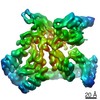 4736MC  4739C  4741C  4742C  4744C 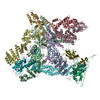 6r7fC  6r7hC  6r7iC  6r7nC M: map data used to model this data C: citing same article ( |
|---|---|
| Similar structure data |
- Links
Links
- Assembly
Assembly
| Deposited unit | 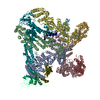
|
|---|---|
| 1 |
|
- Components
Components
-COP9 signalosome complex subunit ... , 8 types, 8 molecules ABCDEFHG
| #1: Protein | Mass: 55606.496 Da / Num. of mol.: 1 Source method: isolated from a genetically manipulated source Source: (gene. exp.)  Homo sapiens (human) / Gene: GPS1, COPS1, CSN1 / Cell line (production host): SF9 / Production host: Homo sapiens (human) / Gene: GPS1, COPS1, CSN1 / Cell line (production host): SF9 / Production host:  |
|---|---|
| #2: Protein | Mass: 51664.570 Da / Num. of mol.: 1 Source method: isolated from a genetically manipulated source Source: (gene. exp.)  Homo sapiens (human) / Gene: COPS2, CSN2, TRIP15 / Cell line (production host): SF9 / Production host: Homo sapiens (human) / Gene: COPS2, CSN2, TRIP15 / Cell line (production host): SF9 / Production host:  |
| #3: Protein | Mass: 45808.816 Da / Num. of mol.: 1 Source method: isolated from a genetically manipulated source Source: (gene. exp.)  Homo sapiens (human) / Gene: COPS3, CSN3 / Cell line (production host): SF9 / Production host: Homo sapiens (human) / Gene: COPS3, CSN3 / Cell line (production host): SF9 / Production host:  |
| #4: Protein | Mass: 46322.688 Da / Num. of mol.: 1 Source method: isolated from a genetically manipulated source Source: (gene. exp.)  Homo sapiens (human) / Gene: COPS4, CSN4 / Cell line (production host): SF9 / Production host: Homo sapiens (human) / Gene: COPS4, CSN4 / Cell line (production host): SF9 / Production host:  |
| #5: Protein | Mass: 37621.742 Da / Num. of mol.: 1 Source method: isolated from a genetically manipulated source Source: (gene. exp.)  Homo sapiens (human) / Gene: COPS5, CSN5, JAB1 / Cell line (production host): SF9 / Production host: Homo sapiens (human) / Gene: COPS5, CSN5, JAB1 / Cell line (production host): SF9 / Production host:  References: UniProt: Q92905, Hydrolases; Acting on peptide bonds (peptidases) |
| #6: Protein | Mass: 34713.844 Da / Num. of mol.: 1 Source method: isolated from a genetically manipulated source Source: (gene. exp.)  Homo sapiens (human) / Gene: COPS6, CSN6, HVIP / Cell line (production host): SF9 / Production host: Homo sapiens (human) / Gene: COPS6, CSN6, HVIP / Cell line (production host): SF9 / Production host:  |
| #7: Protein | Mass: 23245.543 Da / Num. of mol.: 1 Source method: isolated from a genetically manipulated source Source: (gene. exp.)  Homo sapiens (human) / Gene: COPS8, CSN8 / Cell line (production host): SF9 / Production host: Homo sapiens (human) / Gene: COPS8, CSN8 / Cell line (production host): SF9 / Production host:  |
| #13: Protein | Mass: 23228.529 Da / Num. of mol.: 1 Source method: isolated from a genetically manipulated source Source: (gene. exp.)  Homo sapiens (human) / Gene: COPS7B, CSN7B / Cell line (production host): SF9 / Production host: Homo sapiens (human) / Gene: COPS7B, CSN7B / Cell line (production host): SF9 / Production host:  |
-Protein , 5 types, 5 molecules OPQRV
| #8: Protein | Mass: 87098.930 Da / Num. of mol.: 1 Source method: isolated from a genetically manipulated source Source: (gene. exp.)  Homo sapiens (human) / Gene: CUL2 / Cell line (production host): SF9 / Production host: Homo sapiens (human) / Gene: CUL2 / Cell line (production host): SF9 / Production host:  |
|---|---|
| #9: Protein | Mass: 11819.483 Da / Num. of mol.: 1 Source method: isolated from a genetically manipulated source Source: (gene. exp.)  Homo sapiens (human) / Gene: ELOB, TCEB2 / Cell line (production host): SF9 / Production host: Homo sapiens (human) / Gene: ELOB, TCEB2 / Cell line (production host): SF9 / Production host:  |
| #10: Protein | Mass: 11338.760 Da / Num. of mol.: 1 Source method: isolated from a genetically manipulated source Source: (gene. exp.)  Homo sapiens (human) / Cell line (production host): SF9 / Production host: Homo sapiens (human) / Cell line (production host): SF9 / Production host:  |
| #11: Protein | Mass: 10092.631 Da / Num. of mol.: 1 Source method: isolated from a genetically manipulated source Source: (gene. exp.)  Homo sapiens (human) / Cell line (production host): SF9 / Production host: Homo sapiens (human) / Cell line (production host): SF9 / Production host:  |
| #12: Protein | Mass: 17330.764 Da / Num. of mol.: 1 Source method: isolated from a genetically manipulated source Source: (gene. exp.)  Homo sapiens (human) / Gene: VHL / Cell line (production host): SF9 / Production host: Homo sapiens (human) / Gene: VHL / Cell line (production host): SF9 / Production host:  |
-Non-polymers , 1 types, 1 molecules 
| #14: Chemical | ChemComp-ZN / |
|---|
-Experimental details
-Experiment
| Experiment | Method: ELECTRON MICROSCOPY |
|---|---|
| EM experiment | Aggregation state: PARTICLE / 3D reconstruction method: single particle reconstruction |
- Sample preparation
Sample preparation
| Component | Name: Cullin-Ring E3 Ligases (CRLs) complexes with neddylated COP9 signalosome (CSN) Type: COMPLEX / Entity ID: #1-#13 / Source: RECOMBINANT |
|---|---|
| Source (natural) | Organism:  Homo sapiens (human) Homo sapiens (human) |
| Source (recombinant) | Organism:  |
| Buffer solution | pH: 7.5 Details: 15 mM Hepes pH 7.5 100 mM NaCl 0.5 mM DTT 1% glycerol |
| Specimen | Embedding applied: NO / Shadowing applied: NO / Staining applied: NO / Vitrification applied: YES |
| Vitrification | Instrument: FEI VITROBOT MARK IV / Cryogen name: NITROGEN |
- Electron microscopy imaging
Electron microscopy imaging
| Experimental equipment |  Model: Titan Krios / Image courtesy: FEI Company |
|---|---|
| Microscopy | Model: FEI TITAN KRIOS |
| Electron gun | Electron source:  FIELD EMISSION GUN / Accelerating voltage: 300 kV / Illumination mode: FLOOD BEAM FIELD EMISSION GUN / Accelerating voltage: 300 kV / Illumination mode: FLOOD BEAM |
| Electron lens | Mode: BRIGHT FIELD / Nominal magnification: 47170 X / Nominal defocus max: 3000 nm / Nominal defocus min: 1800 nm / Cs: 2.7 mm / C2 aperture diameter: 100 µm |
| Specimen holder | Cryogen: NITROGEN / Specimen holder model: FEI TITAN KRIOS AUTOGRID HOLDER |
| Image recording | Electron dose: 45 e/Å2 / Detector mode: COUNTING / Film or detector model: GATAN K2 QUANTUM (4k x 4k) |
| EM imaging optics | Energyfilter name: GIF Bioquantum / Energyfilter slit width: 30 eV |
- Processing
Processing
| CTF correction | Type: PHASE FLIPPING AND AMPLITUDE CORRECTION |
|---|---|
| Symmetry | Point symmetry: C1 (asymmetric) |
| 3D reconstruction | Resolution: 8.4 Å / Resolution method: FSC 0.143 CUT-OFF / Num. of particles: 24040 / Symmetry type: POINT |
 Movie
Movie Controller
Controller


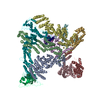

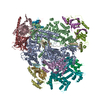


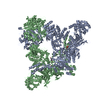
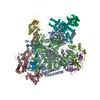
 PDBj
PDBj